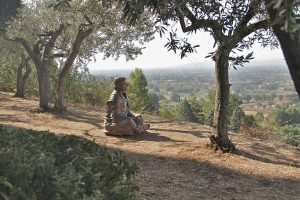 St. Francis, often called the patron saint of ecology, founded the creation-centered Franciscan Order. He is known for having received the stigmata near the end of his life – literal wounds in the palms of his hands that symbolize and commemorate the crucifixion of Jesus.
St. Francis, often called the patron saint of ecology, founded the creation-centered Franciscan Order. He is known for having received the stigmata near the end of his life – literal wounds in the palms of his hands that symbolize and commemorate the crucifixion of Jesus.
As St. Francis meditated and prayed, he focused on the historical, embodied Second Person of the Trinity, Jesus of Nazareth. He prayed fervently with the Gospels, and he experienced an intense imaginative identification with Jesus. Like the bride in the Song of Songs who seeks consummation with the holy Bridegroom, Francis sought to lose his life in the life of Jesus.
Francis felt that the veil of time and space between Jesus and himself was so thin that he could hear Jesus’ voice. Once, when praying with an icon of the crucified Jesus in the Assisi church of San Damiano, he heard Jesus say, “Francis, Francis, go and repair my house which, as you can see, is falling into ruins.” Francis immediately acted on this communication, selling some of his father’s goods to help repair the church (his father punished him for this infraction). Francis also heard Jesus’ words in the Gospels as directed to him personally. Upon hearing a sermon based on Matthew 10:8-11, Francis took Jesus’ command literally: he left his family and privileged station and began living in poverty, devoting his life to the poor and the sick. Francis’ way was Jesus’s way, and in the eyes of his followers, Francis’ presence and actions coincided completely with the presence and actions of Jesus.
Francis’ I-Thou relationship with Jesus extended to all of God’s creation. His well-known composition, “The Canticle of Creation,” praises natural elements, using terms such as Brother Sun, Sister Moon, Sister Earth, and Our Mother. Francis considered all creatures to be his siblings because they shared the same Creator. St. Bonaventure, generally considered Francis’ chief biographer, wrote that Francis cultivated a sacred I-thou rapport with birds, pigs, snakes, and donkeys. St. Francis’ awareness was so fixed on Jesus of Nazareth as the Second Person of the Trinity that one could argue that he himself was transfigured into the I-Thou consciousness of Jesus.
A famous prayer attributed to St. Francis conveys his love for the Prince of Peace:
Lord, make me an instrument of your peace.
Where there is hatred, let me sow love.
Where there is injury, pardon.
Where there is doubt, faith.
Where there is despair, hope.
Where there is darkness, light.
Where there is sadness, joy…
Francis’ commitment to an empathetic and compassionate life with people and all creatures is exemplary, even though contemporary psychologists might understandably conclude that his “relationship” with Jesus of Nazareth was either imaginal (after the work of Jungian psychologist James Hillman) or a case of projection (after psychologists Jung, Freud, and others). But even if his spiritual life is dissected in this way, there is now doubt that he co-created a vibrant community that has survived centuries and contributed greatly to the interPersonal dimension of trinitarian consciousness.